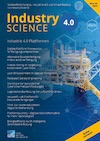Search


Bibtex
Cite as text
@Article{Rojahn,
Cite-key = "Rojahn2024Dig",
Year= "2024",
Number= "2",
Volume= "Industry 4.0 Science 40",
Pages= "8-15",
Journal = "Industry 4.0 Science",
Title= "Digitale Plattform Frameworks für Fertigungsunternehmen - Ein Überblick",
Author= "Marcel Rojahn, Universität Potsdam",
Doi= "https://doi.org/10.30844/I4SD.24.2.8",
Abstract= "Das sich im Aufbau befindliche dezentrale Datenökosystem Gaia-X unterstützt die Zukunftsfähigkeit der digitalen Datenwirtschaft in Europa. Aber wie können relevante Use Cases aus serviceorientierter Sicht in Gaia-X realisiert werden? Um diese Frage zu beantworten, wird in diesem Beitrag eine Methodik vorgestellt, die eine strukturierte und interdisziplinäre Herangehensweise für die Service-Entwicklung im laufenden Konsortialforschungsprojekt Gaia-X 4 ROMS beschreibt [1]. Darin werden föderierte Services auf der Basis von Use Cases in fünf Bearbeitungsschritten realisiert. IT-Experten, Softwareentwickler
und Branchenanwender können das Modell nutzen, um das gemeinsame Vorgehen zur Realisierung von Use Cases mit Gaia-X und dem Ziel eines
souveränen Datenaustauschs effizient zu koordinieren.",
Keywords= "Digitale Plattformen, industrielles Internet der Dinge, systematische
Literaturrecherche",
}
Marcel Rojahn, Universität Potsdam(2024): Digitale Plattform Frameworks für Fertigungsunternehmen - Ein Überblick. Industry 4.0 Science 402(2024), S. 8-15. Online: https://doi.org/10.30844/I4SD.24.2.8 (Abgerufen 06.07.25)
Open Access
Abstract
Abstract
Das sich im Aufbau befindliche dezentrale Datenökosystem Gaia-X unterstützt die Zukunftsfähigkeit der digitalen Datenwirtschaft in Europa. Aber wie können relevante Use Cases aus serviceorientierter Sicht in Gaia-X realisiert werden? Um diese Frage zu beantworten, wird in diesem Beitrag eine Methodik vorgestellt, die eine strukturierte und interdisziplinäre Herangehensweise für die Service-Entwicklung im laufenden Konsortialforschungsprojekt Gaia-X 4 ROMS beschreibt [1]. Darin werden föderierte Services auf der Basis von Use Cases in fünf Bearbeitungsschritten realisiert. IT-Experten, Softwareentwickler und Branchenanwender können das Modell nutzen, um das gemeinsame Vorgehen zur Realisierung von Use Cases mit Gaia-X und dem Ziel eines souveränen Datenaustauschs effizient zu koordinieren.
Keywords
Schlüsselwörter
Digitale Plattformen, industrielles Internet der Dinge, systematische Literaturrecherche
References
Referenzen
[1] Henfridsson, O. u. a.: Managing Technological Change in the Digital Age: The Role of Architectural Frames. In: Journal of Information Technology 29 (2014) 1, S. 27-43. DOI: 10.1057/ jit.2013.30.
[2] Andreev, S. u. a.: Internet of Things, Smart Spaces, and Next Generation Networking. In: Lecture Notes in Computer Science (7469) (2012). DOI: 10.1007/978-3-642-32686-8.
[3] Sethi, S.; Sarangi, S. R.: Internet of Things: Architectures, Protocols, and Applications. In: Journal of Electrical and Computer Engineering 2017, S. 1-25. DOI: 10.1155/2017/9324035.
[4] Guth, J.; Breitenbucher, U.; Falkenthal, M.; Leymann, F.; Reinfurt, L.: Comparison of IoT platform architectures: A field study based on a reference architecture. In: Proc. Cloudification Internet Things (CIoT) (2017), S. 1-6. DOI: 10.1109/ CIOT.2016.7872918.
[5] Schuh, G.; Hoffmann, J.; Gruber, M.; Zeller, V.: Managing IT complexity in the manufacturing industry—An agenda for action. In: Journal on Systemics, Cybernetics and Informatics (15) (2017) 2, S. 61-65.
[6] Rojahn M.; Gronau, N.: Digital Platform Concepts for manufacturing Companies – A Review. In: 10th International Conference on Future Internet of Things and Cloud (FiCloud) (2023), S. 149-158. DOI: 10.1109/FiCloud58648.2023.00030.
[7] Fettke, S.: State-of-the-Art des State-of-the-Art: Eine Untersuchung der Forschungsmethode „Review“ innerhalb der Wirtschaftsinformatik. In: Wirtschaftsinformatik 48 (2006) 4, S. 257.
[8] Ullah, M. u. a.: Twenty-one key factors to choose an IoT platform: Theoretical framework and its applications. In: IEEE Internet of Things Journal 7 (2020) 10, S. 10111-10119. DOI: 10.1109/JIOT.2020.3000056.
[9] Li, J. u. a.: Study on the reference architecture and assessment framework of industrial internet platform. In: IEEE Access 8 (2020), S. 164950- 164971. DOI: 10.1109/ACCESS.2020.3021719.
[10] Benitez, G. B. u. a.: Industry 4.0 innovation ecosystems: An evolutionary perspective on value cocreation. In: International Journal of Production Economics 228 (2020), S. 107735.
[11] Weking, J. u. a.: Leveraging industry 4.0–A business model pattern framework. In: International Journal of Production Economics 225 (2020), S. 107588. DOI: 10.1016/j.ijpe.2019.107588.
[12] Rajput, S.; Singh, S. P.: Identifying Industry 4.0 IoT enablers by integrated PCA-ISM-DEMATEL approach. In: Management Decision 57 (2018) 8, S. 1784-1817. DOI: 10.1108/MD-04-2018-0378.
[13] Wankhede, P.; Talati, M.; Chinchamalatpure, R.: Comparative study of cloud platforms- microsoft azure, google cloud platform and amazon EC2. In: Journal Research Engineering Application Science 5 (2020) 2, S. 60-64. DOI: 10.46565/jreas.2020.v05i02.004.
[14] Salami, A.; Yari, A.: A framework for comparing quantitative and qualitative criteria of IoT platforms. In: 4th International Conference on Web Research (ICWR) (2018). IEEE.
[15] Hoffmann, J. B. u. a.: IoT platforms for the Internet of production. In: IEEE Internet of Things Journal 6 (2018) 3, S. 4098- 4105. DOI: 10.1109/JIOT.2018.2875594.
[16] Farshidi, S. u. a.: Decision support for blockchain platform selection: Three industry case studies. In: IEEE transactions on Engineering management 67 (2020) 4, S. 1109-1128. DOI: 10.1109/TEM.2019.2956897.
[17] Huo, R. u. a.: A comprehensive survey on blockchain in industrial internet of things: Motivations, research progresses, and future challenges. In: IEEE Communications Surveys & Tutorials 24 (2022) 1, S. 88-122. DOI: 10.1109/COMST.2022.3141490.
[18] Rojahn, M.; Gronau, N.: Openness Indicators for the Evaluation of Digital Platforms between the Launch and Maturity Phase. In: Proceedings of the 57th Hawaii International Conference on System Sciences (2024), S. 4516-4525.
[19] Ismail, A. A.; Hamza, H. S.; Kotb, A. M.: Performance evaluation of open source IoT platforms. In: IEEE global conference on internet of things (GCIoT) (2018). IEEE.
[20] Moeuf, A. u. a.: The industrial management of SMEs in the era of Industry 4.0. In: International journal of production research 56 (2018) 3, S. 1118-1136. DOI: 10.1080/00207543.2017.1372647.
[21] Siqin, T. u. a.: Platform operations in the industry 4.0 era: recent advances and the 3As framework. In: IEEE Transactions on Engineering Management (2022). DOI: 10.1109/TEM.2021.3138745.
[22] Ray, P. P.: A survey on Internet of Things architectures. In: Journal of King Saud University Computer and Information Sciences 30 (2018) 3, S. 291-319. DOI: 10.1016/j.jksuci.2016.10.003.

 English
English